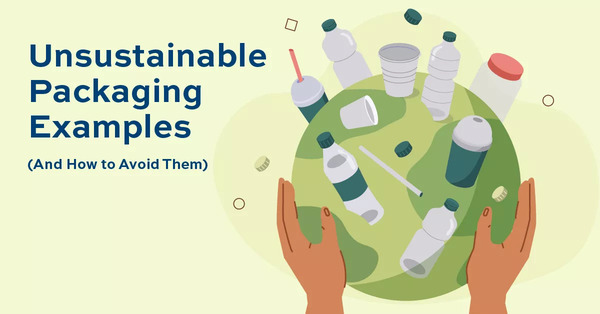


Data shows that consumers want more eco-friendly business practices. To follow this trend, start by learning about unsustainable packaging.
Product packaging is essential in protecting goods during transit and boosting brand visibility. However, not all materials are equal. Some packaging types, like plastics, are harmful to the environment. Understanding the implications of your packaging materials is crucial to maintaining your organization’s reputation in an increasingly eco-conscious landscape.
Check out the infographic below for some examples of unsustainable packaging. This way, you can make smarter choices about your packaging materials. But before that, let’s talk about some important stats showing the move towards sustainability.
These numbers highlight why it’s crucial to switch to eco-friendly packaging to lessen the harm unsustainable options cause.
A staggering 36% of all plastics the world produces are in packaging, 85% of which end up in landfills or as unregulated waste. These materials consist of single-use plastics from food and beverage products, including cups, straws, and wrapping.
Consumers use 50% of all plastic packaging is thrown away after just one use. Additionally, the world consumes 500 billion plastic bags annually, with an average “working life” of 15 minutes—roughly one million bags per minute. These figures emphasize plastic’s role in environmental degradation.
A staggering 98% of single-use plastics come from fossil fuels, the production of which emits enormous amounts of greenhouse gases (GHG). In the food and beverage industry, packaging comprises 5% of the energy every product consumes.
According to the EPA’s most recent data, only half of all product packaging undergo recycling—that’s 44.3 million tons of the 82.2 million tons the industry generates annually. Moreover, 30.4 million tons only end up in landfills, undermining worldwide recycling efforts.
Over 14 million tons of plastics end up in the ocean yearly, making up most marine debris from the surface to the deep sea. Marine life inevitably ingests these materials and consequently suffers from injury and death. This issue also threatens human health, as scientists have found traces of microplastics in edible fish.
Many consumers prefer sustainable packaging materials like folding carton packaging, glass, and metal. So, it’s time to switch from plastic to paper to satisfy customers and remain competitive in an increasingly sustainability-focused business environment.
To boost your sales and customer loyalty, prioritize sustainability in your product and packaging development. Two-thirds of consumers would pay more for eco-friendly products, with 77% stating that sustainability is essential to their purchasing decisions.
Also, 69% of companies plan to change their policies within the next five years. These investments primarily focus on their organizations’ ecological impact (69%), indicating a growing trend toward environmental sustainability. Jumping on this movement is crucial to keep your company competitive.
Transparency is also vital to your efforts. Products making these claims experienced a 28% cumulative sales growth from 2017 to 2022, by contrast to 20% for those that didn’t. Adding environmental certifications and slogans to your product packaging can help.
As shoppers become more aware of the impact of their purchasing decisions, businesses like yours need to recognize the importance of sustainable practices. This shift must also extend to packaging—something many entrepreneurs overlook. It will help preserve the environment and align your practices to eco-conscious trends, positioning your organization for lasting customer support.
Take your first steps towards sustainability by reading more about unsustainable packaging in this infographic.
